Birdfinding.info ⇒ Common in the central and southern Bahamas. Rare and irregular on Grand Bahama. On Abaco, it is uncommon in the north, but common in the south; readily found in Abaco National Park. In Turks & Caicos, it seems to be most numerous on Providenciales. In Cuba, it is most easily found on Cayo Guillermo, but is also found regularly on neighboring islands. On Jamaica, it can usually be found on early morning visits to Portland Ridge and the Hellshire Hills. Records from southeastern Florida have increased to multiple birds in most years, with the vast majority appearing in April or May anywhere between Fort Lauderdale and the Dry Tortugas.
Bahama Mockingbird
Mimus gundlachii
Endemic to the western Antilles. Occurs throughout the Bahamas and Turks & Caicos, on Cuba’s northern keys (Cayos Guillermo, Coco, Romano, and Paredón Grande, and southern Jamaica.
Inhabits dry woodlands and dense scrub across most of its range. The Jamaican subspecies hillii is highly localized in arid scrub and dry limestone forest along the south-central coast, known only from the Hellshire Hills and Portland Ridge, but may also occur in similar habitat in the Braziletto Hills.
Regularly wanders to southern Florida and the Cuban mainland. Most Florida records are of birds discovered in April or May. This pattern is strong enough to suggest that birds found at other times of year may have strayed in April or May, then remained until they were eventually detected.
Identification
A gray-and-brown mockingbird with irregular streaks and speckles. Its most consistent diagnostic feature is the bold streaking on its flanks.
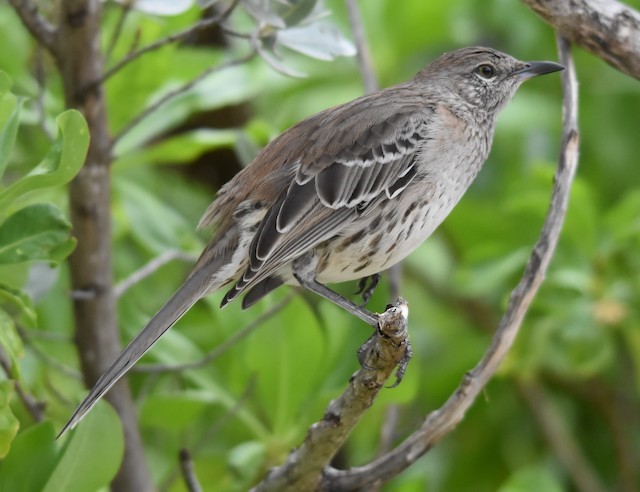
Bahama Mockingbird. (Half Moon Cay, Little San Salvador, Bahamas; December 11, 2015.) © Keith Gregoire
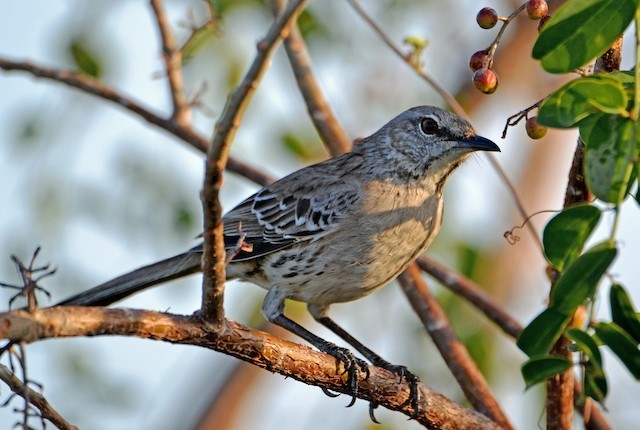
Bahama Mockingbird. (Playa Pilar, Cayo Guillermo, Ciego de Ávila, Cuba; April 7, 2016.) © Michael J. Good

Bahama Mockingbird. (Garden Key, Dry Tortugas National Park, Florida; May 4, 2007.) © Brennan Mulrooney
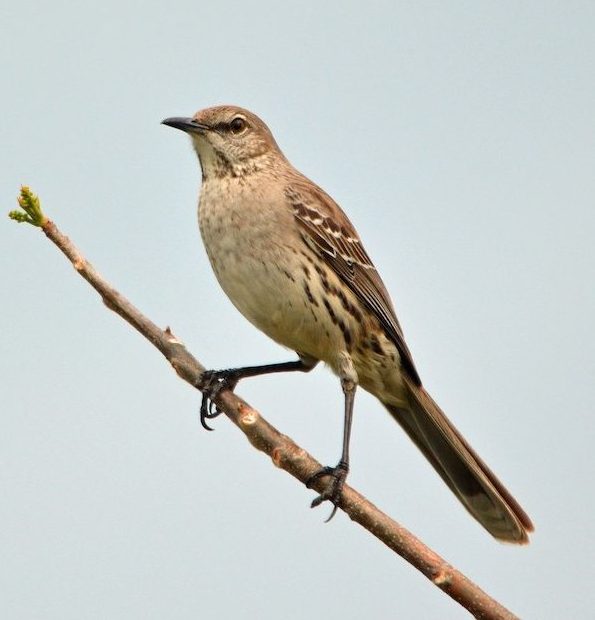
Bahama Mockingbird. (Cayo Guillermo, Ciego de Ávila, Cuba; April 12, 2019.) © Michael J. Good
The upperparts are brownish-gray with somewhat browner or darker streaks. Some individuals tend more toward brown overall, while a few are just gray. Usually shows two narrow whitish wingbars.
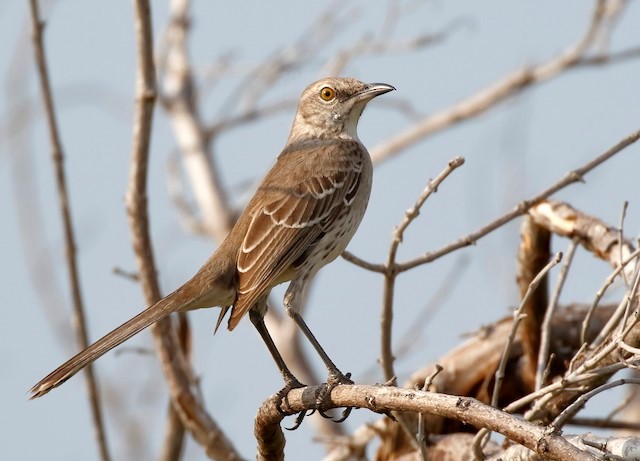
Bahama Mockingbird. (Cayo Coco, Ciego de Ávila, Cuba; March 4, 2019.) © Dave Curtis
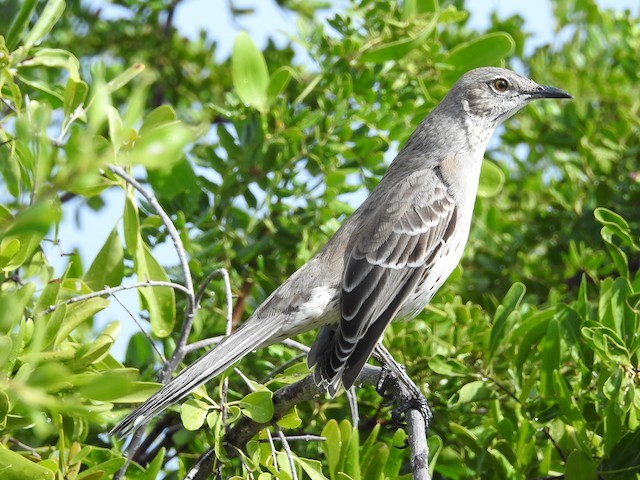
Bahama Mockingbird, grayer than most—thus potentially confused with Northern Mockingbird. (Half Moon Cay, Little San Salvador, Bahamas; December 1, 2017.) © Richard A. Fischer
When it spreads its tail, it flashes white tips on the tail feathers. These are always visible from below, but usually concealed when the tail is folded.
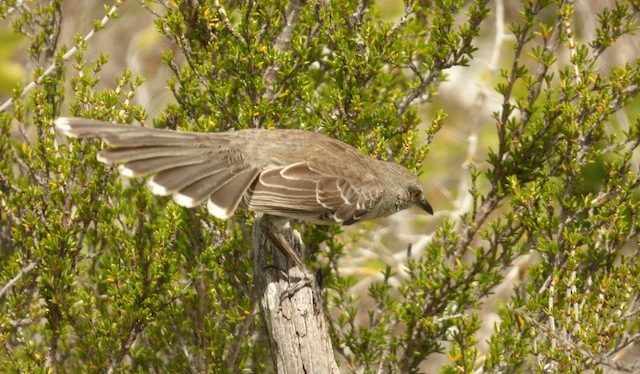
Bahama Mockingbird, showing its white-tipped tail. (Dangie’s Beach, Great Inagua, Bahamas; March 31, 2018.) © Tarra Lindo

Bahama Mockingbird, showing browner streaks on upperparts. (Man-O-War Sound, Central Andros, Bahamas; April 19, 2016.) © Erika Gates
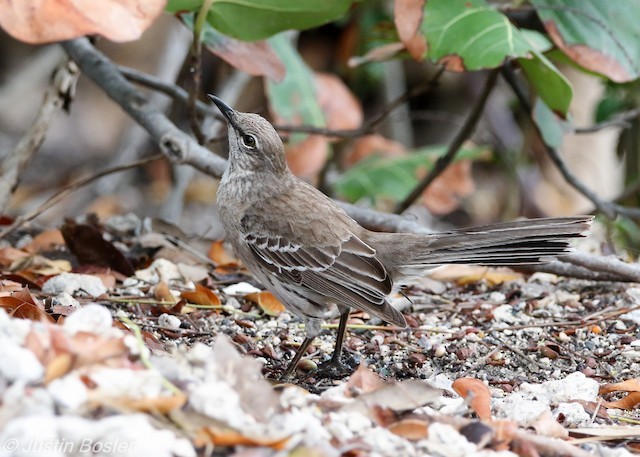
Bahama Mockingbird. (Anne’s Beach, Lower Matecumbe Key, Florida; April 23, 2017.) © Justin Bosler

Bahama Mockingbird, a gray individual—note fine brownish streaks on the crown. (The Retreat, New Providence, Bahamas; December 5, 2017.) © Christopher Johnson
The upper breast is usually pale gray with some combination of speckles, thin streaks, and vague spots. The lower breast and belly are white, unmarked in the middle, with bold streaks toward the flanks.
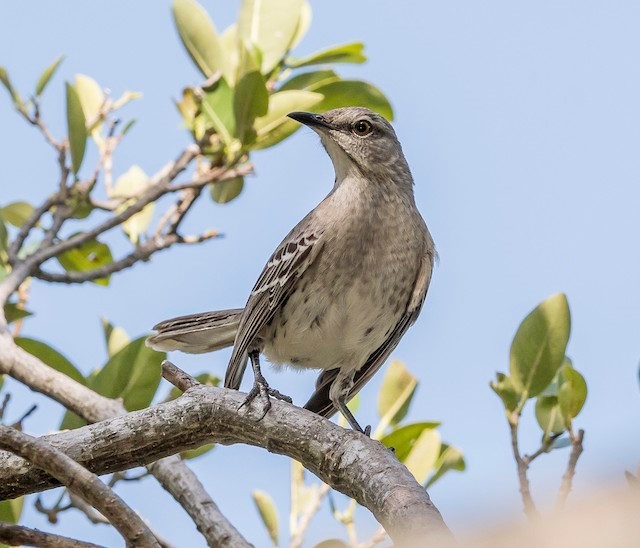
Bahama Mockingbird, showing vague spots on the breast. (Evergreen Cemetery, Fort Lauderdale, Florida; April 24, 2017.) © David Hall

Bahama Mockingbird, indistinctly marked except for the bold streaks on the flank—also note the fine streaks on the breast. (Gulfstream Shores, Key Largo, Florida; May 8, 2018.) © Rangel Diaz

Bahama Mockingbird, showing an essentially all-white breast. (Hellshire Hills, Jamaica; February 2014.) © Tom Davis
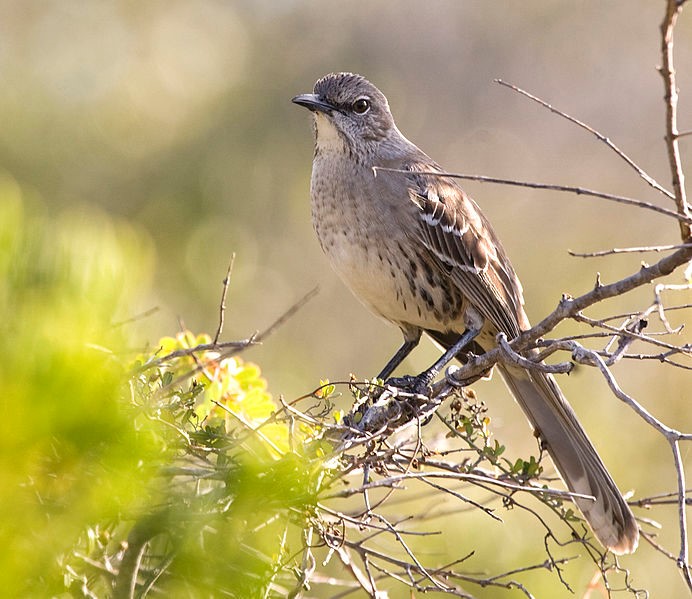
Bahama Mockingbird. (Cayo Coco, Ciego de Ávila, Cuba; February 16, 2011.) © Laura C. Gooch
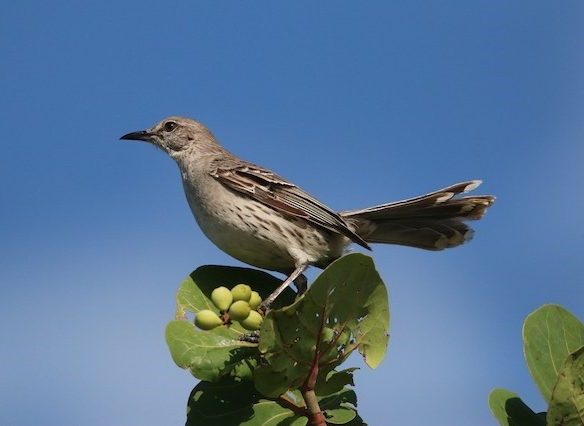
Bahama Mockingbird, showing white tips on the undertail. (Half Moon Cay, Little San Salvador, Bahamas; May 29, 2017.) © Ken Oeser
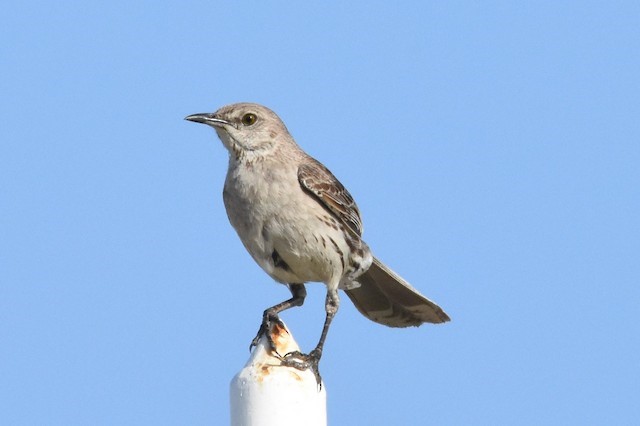
Bahama Mockingbird, with a grayish, nearly unmarked breast—note the diagnostic streaks on the flank. (Cayo Guillermo, Ciego de Ávila, Cuba; July 20, 2017.) © Andrew Dobson

Bahama Mockingbird, showing a grayish breast with a few brown speckles. (Hellshire Hills, Jamaica; December 11, 2016.) © Arjan Dwarshuis
Usually shows dark whisker marks that frame a clean white throat; however, on some individuals these marks can be very faint. Has thin white crescents above and below the eye, visible at close range.
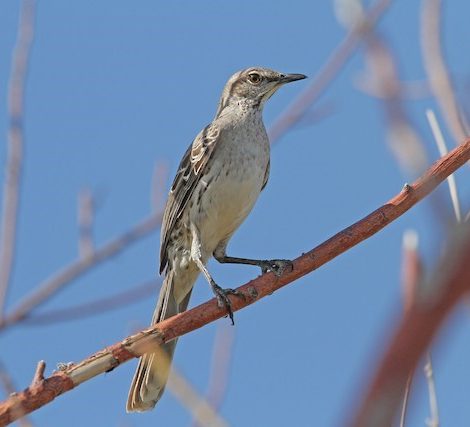
Bahama Mockingbird, showing a speckled breast and distinct whisker mark. (Cayo Guillermo, Ciego de Ávila, Cuba; February 25, 2018.) © Christoph Moning
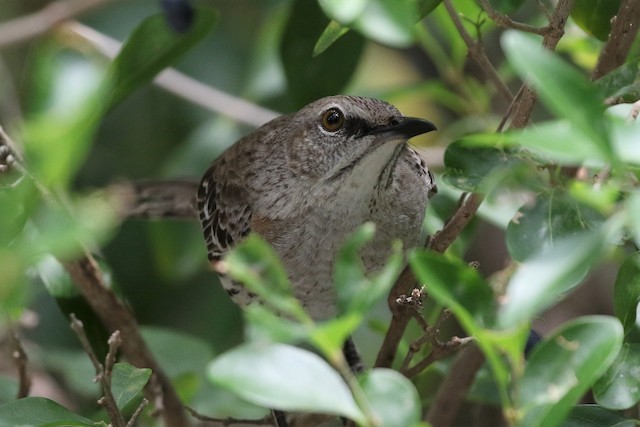
Bahama Mockingbird, showing dark whisker marks, white throat, and white eye-crescents. (Lantana Nature Preserve, Lantana, Florida; April 26, 2019.) © Ethan Goodman
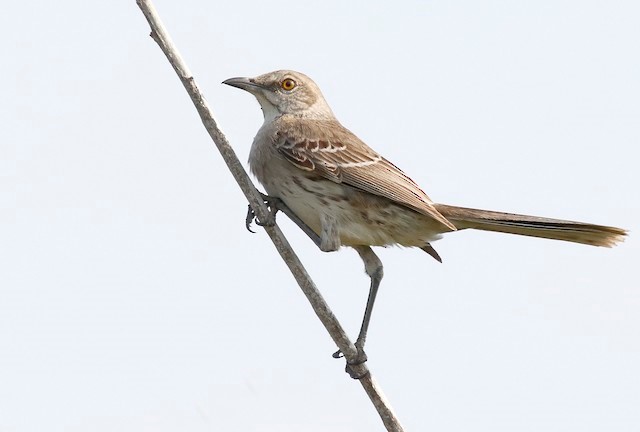
Bahama Mockingbird. (Cayo Coco, Ciego de Ávila, Cuba; March 4, 2019.) © Dave Curtis
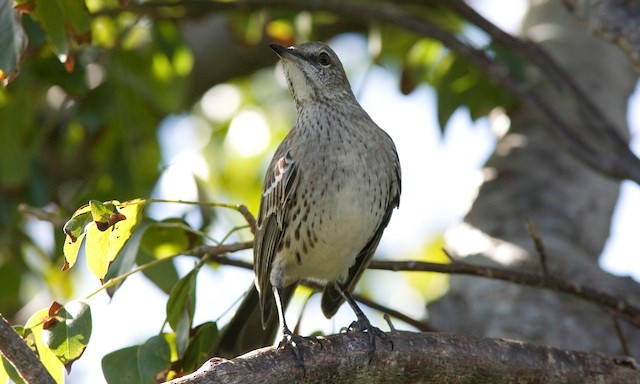
Bahama Mockingbird. (Elbow Cay, Abaco, Bahamas; January 5, 2008.) © Brian Sullivan

Bahama Mockingbird, showing a minimal whisker mark. (Windley Key Fossil Reef Geological State Park, Florida; April 21, 2017.) © Darrell Lawson
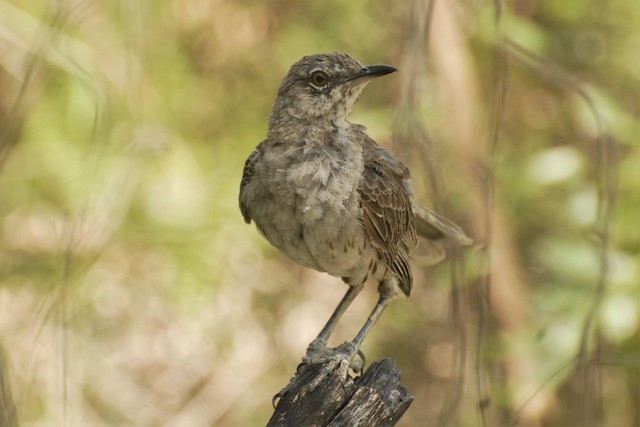
Bahama Mockingbird, apparently an immature. (Churches Blue Hole, North Andros, Bahamas; August 16, 2013.) © David Hollie
Voice. Song is loud and clear, usually consisting of a brief phrase or set of phrases repeated many times with small variations, often shifting to similar phrases and repeating them:
Calls include raspy but soft scolding:
Cf. Northern Mockingbird. Bahama Mockingbird resembles an immature Northern Mockingbird, which is common throughout Bahama’s range. Bahama is about 10% longer than Northern, heavier-bodied, browner overall, and more retiring in its habits. In flight, Northern flashes large white wing-patches and outer tail feathers, whereas on Bahama the white is limited to the tips of the tail feathers.
Both have some marks on the underparts: immature Northern has spots on the breast, becoming fainter on the flanks, whereas on Bahama the pattern is inverted, with vague spots or fine speckles on the breast and bold streaks on the flanks.
Bahama usually shows dark whisker streaks that frame a clean white throat; however, on some individuals the streaks can be very faint—and some young Northern Mockingbirds also have faint whisker marks and a clean white throat.
Notes
Polytypic species consisting of two recognized subspecies.
References
Alderfer, J., and J.L. Dunn. 2014. National Geographic Complete Birds of North America (Second Edition). National Geographic Society, Washington, D.C.
eBird. 2019. eBird: An online database of bird distribution and abundance. Cornell Lab of Ornithology, Ithaca, N.Y. http://www.ebird.org. (Accessed May 14, 2019.)
Haynes-Sutton, A., A. Downer, R. Sutton, and Y.-J. Rey-Millet. 2009. A Photographic Guide to the Birds of Jamaica. Princeton University Press, Princeton, N.J.
Howell, S.N.G., I. Lewington, and W. Russell. 2014. Rare Birds of North America. Princeton University Press, Princeton, N.J.
Raffaele, H., J. Wiley, O. Garrido, A. Keith, and J. Raffaele. 1998. A Guide to the Birds of the West Indies. Princeton University Press, Princeton, N.J.
Rolling Harbour. 2017. Bahama Mockingbirds on Abaco: Good Impressions. https://rollingharbour.com/2017/04/26/bahama-mockingbirds-on-abaco-good-impressions/.
